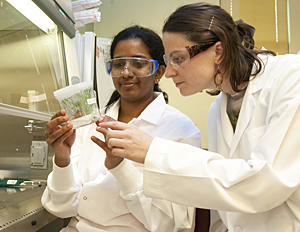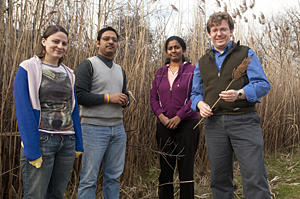

ADVERTISEMENT
- Rozovsky wins prestigious NSF Early Career Award
- UD students meet alumni, experience 'closing bell' at NYSE
- Newark Police seek assistance in identifying suspects in robbery
- Rivlin says bipartisan budget action, stronger budget rules key to reversing debt
- Stink bugs shouldn't pose problem until late summer
- Gao to honor Placido Domingo in Washington performance
- Adopt-A-Highway project keeps Lewes road clean
- WVUD's Radiothon fundraiser runs April 1-10
- W.D. Snodgrass Symposium to honor Pulitzer winner
- New guide helps cancer patients manage symptoms
- UD in the News, March 25, 2011
- For the Record, March 25, 2011
- Public opinion expert discusses world views of U.S. in Global Agenda series
- Congressional delegation, dean laud Center for Community Research and Service program
- Center for Political Communication sets symposium on politics, entertainment
- Students work to raise funds, awareness of domestic violence
- Equestrian team wins regional championship in Western riding
- Markell, Harker stress importance of agriculture to Delaware's economy
- Carol A. Ammon MBA Case Competition winners announced
- Prof presents blood-clotting studies at Gordon Research Conference
- Sexual Assault Awareness Month events, programs announced
- Stay connected with Sea Grant, CEOE e-newsletter
- A message to UD regarding the tragedy in Japan
- More News >>
- March 31-May 14: REP stages Neil Simon's 'The Good Doctor'
- April 2: Newark plans annual 'wine and dine'
- April 5: Expert perspective on U.S. health care
- April 5: Comedian Ace Guillen to visit Scrounge
- April 6, May 4: School of Nursing sponsors research lecture series
- April 6-May 4: Confucius Institute presents Chinese Film Series on Wednesdays
- April 6: IPCC's Pachauri to discuss sustainable development in DENIN Dialogue Series
- April 7: 'WVUDstock' radiothon concert announced
- April 8: English Language Institute presents 'Arts in Translation'
- April 9: Green and Healthy Living Expo planned at The Bob
- April 9: Center for Political Communication to host Onion editor
- April 10: Alumni Easter Egg-stravaganza planned
- April 11: CDS session to focus on visual assistive technologies
- April 12: T.J. Stiles to speak at UDLA annual dinner
- April 15, 16: Annual UD push lawnmower tune-up scheduled
- April 15, 16: Master Players series presents iMusic 4, China Magpie
- April 15, 16: Delaware Symphony, UD chorus to perform Mahler work
- April 18: Former NFL Coach Bill Cowher featured in UD Speaks
- April 21-24: Sesame Street Live brings Elmo and friends to The Bob
- April 30: Save the date for Ag Day 2011 at UD
- April 30: Symposium to consider 'Frontiers at the Chemistry-Biology Interface'
- April 30-May 1: Relay for Life set at Delaware Field House
- May 4: Delaware Membrane Protein Symposium announced
- May 5: Northwestern University's Leon Keer to deliver Kerr lecture
- May 7: Women's volleyball team to host second annual Spring Fling
- Through May 3: SPPA announces speakers for 10th annual lecture series
- Through May 4: Global Agenda sees U.S. through others' eyes; World Bank president to speak
- Through May 4: 'Research on Race, Ethnicity, Culture' topic of series
- Through May 9: Black American Studies announces lecture series
- Through May 11: 'Challenges in Jewish Culture' lecture series announced
- Through May 11: Area Studies research featured in speaker series
- Through June 5: 'Andy Warhol: Behind the Camera' on view in Old College Gallery
- Through July 15: 'Bodyscapes' on view at Mechanical Hall Gallery
- More What's Happening >>
- UD calendar >>
- Middle States evaluation team on campus April 5
- Phipps named HR Liaison of the Quarter
- Senior wins iPad for participating in assessment study
- April 19: Procurement Services schedules information sessions
- UD Bookstore announces spring break hours
- HealthyU Wellness Program encourages employees to 'Step into Spring'
- April 8-29: Faculty roundtable series considers student engagement
- GRE is changing; learn more at April 15 info session
- April 30: UD Evening with Blue Rocks set for employees
- Morris Library to be open 24/7 during final exams
- More Campus FYI >>
10:47 a.m., Dec. 23, 2009----University of Delaware researchers have uncovered a novel means of conquest employed by the common reed, Phragmites australis, which ranks as one of the world's most invasive plants.
The invasive strain, which hails from Eurasia, overtakes its “native” cousin, which has lived in North America for the past 10,000 years, ironically by provoking the native plant to “take itself out,” through a combination of microbial and enzymatic activity in the soil.
The research by an interdisciplinary UD team led by Harsh Bais, assistant professor of plant and soil sciences, is reported in the December issue of the scientific journal Plant Physiology and also is highlighted in one of the journal's editorials.
Bais's co-authors include postdoctoral researchers Gurdeep Bains and Amutha Sampath Kumar in the Department of Plant and Soil Sciences in the College of Agriculture and Natural Resources; Thimmaraju Rudrappa, a former UD postdoctoral researcher who is now a research scientist at DuPont; Emily Alff, an undergraduate who became involved in the study through a Research Experiences for Undergraduates (REU) fellowship; and Thomas Hanson, associate professor of marine biosciences in the College of Earth, Ocean, and Environment.
In previous research, a team led by Bais determined that Phragmites employs a strategy known as allelopathy, in which plants release toxic chemicals into the soil to deter other plants from growing close to them.
In soil studies at the Delaware Biotechnology Institute, a premier center for life sciences research at UD, the scientists discovered that invasive Phragmites produces elevated levels of a benign compound, a precursor of gallic acid known as gallotannin, relative to its native cousin.
However, when this gallotannin, a polymeric phenol, is attacked by tannase produced through enzymatic activity by native plants and rhizospheric microbes, toxic gallic acid is produced and released in the root zone, exacerbating the invasive Phragmites' noxiousness.
“The tannins are like partners in crime in the process,” Bais said.
He noted that Hanson and Kumar collected microbes present on the root surface of the plants and revealed that the “bugs” cleave the polymer (gallotannin) to release the monomer (gallic acid) because the microbes are using the tannins as a carbon source.
“It's like a two-way highway,” Bais said, “the plant is working with bacteria to secrete gallic acid into the soil.”
Bais says that the microbial population is the same in the native versus the invasive Phragmites. The invasive variety simply secretes more gallotannins into the soil than its native cousin, putting the native plant at a disadvantage in turf battles between the two strains.
Phragmites has overtaken millions of acres of wetlands in the United States, thanks to the aggressive, invasive strain of the plant that came on the scene some 200 years ago from Eurasia.
The exotic species has displaced the non-aggressive native variety of the plant, relegating the native strain to isolated patches and wetland margins along the Atlantic coast.
“Now we have a way to remedy the sick soil,” Bais said. “After years of research, we have identified a mechanism that may lead to a solution to the Phragmites invasion.”
The research was supported by the University of Delaware Research Foundation (UDRF). Gurdeep Bains's involvement in the study was made possibly by a BOYSCAST Fellowship from the Department of Science and Technology, India.
Article by Tracey Bryant
Photos by Kathy Atkinson


